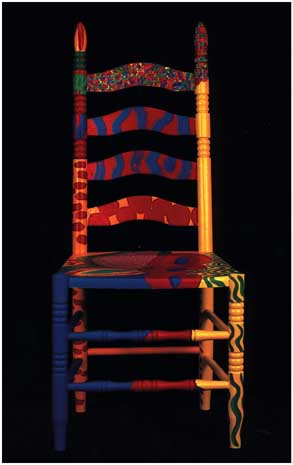
Halstead's fascination with biomorphic imagery, in works such as Physical Traces of Memory and Cytoskeltons (both 1987), finds parallels in earlier modernist painting. Joan Miro's whimsical fantacies and William Baziotes' lyrical abstractions come to mind, but Halstead's canvases also depend on the exuberance of seventies' Pattern Painting, with its celebration of hothouse color and often tropical sensibility. The impacted, painterly surfaces of Sufficient Signals (1986) and Cellular Skeletons (1987), for example, evoke lush atmospheres of vitality and unchecked growth.
The insistent elan of these almost hedonistic meditations on primordial forms and forces erupts to the point of bursting through Halstead's painted borders and framing devices. A joyous modernist, preoccupied with the flatness as well as beauty of her paintings, Halstead also harbors an interest in decoration. The scale and proportions of certain works, such as an expansive, scroll-like canvas In Which Memories are Stored (1986), attest to concerns for creating a decorative environment beyond the purview of easel painting.
Such a propensity for the decorative is reminiscent of Matisse, and indeed some of Halstead's motifs recall those biomorphic, quasi-abstract leaf or flower shapes in the late paper cut-outs. This is not to say, however, that the living organisms that wriggle and float through Halstead's paintings derive from art history. She discovers her motifs in natural history museums, in science books, or under a microscope, but most of all the bubbling laboratory of her imagination. Her vision is of a world where everything relates, where forms and ideas echo across the boundaries of specialized desciplines and transcend categorization.Unexpected new species evolve from Halstead's liberating cross-fertilizations, as she mates art and science to create poetic metaphors of unending delight.
Sue Taylor